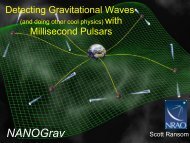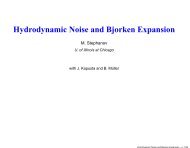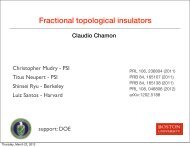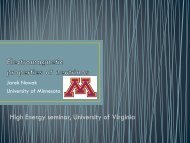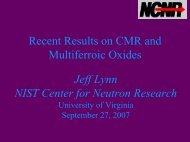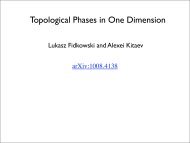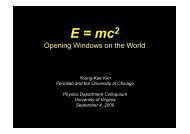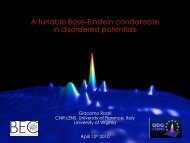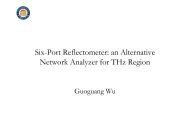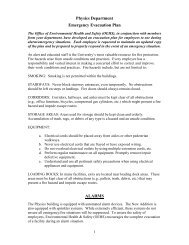Elementary Particles of Superconductivity
Elementary Particles of Superconductivity
Elementary Particles of Superconductivity
You also want an ePaper? Increase the reach of your titles
YUMPU automatically turns print PDFs into web optimized ePapers that Google loves.
April 2011<br />
1. Schafroth’s bosons ?<br />
2. BCS paired electrons ?<br />
3. Lattice Bosons ?!<br />
-- new paradigm <strong>of</strong> metallic<br />
conductivity…
Energy transport<br />
solar cells<br />
nuclear energy<br />
wind energy<br />
15% <strong>of</strong> electric power is wasted in wires resistance!
Resistivity: Boltzmann-Drude Paradigm<br />
1. Electrons in metals behave like a free gas.<br />
2. Uncorrelated scattering causes dissipation.<br />
Ohm<br />
1900<br />
Newton<br />
Kinetic theory<br />
<strong>of</strong> gases<br />
‘scattering time’<br />
dissipation
The race to absolute 0<br />
Dewar 1899<br />
Heike Liquid Kamerlingh H : 14K Onnes<br />
Liquid He : 4K
Discovery <strong>of</strong> <strong>Superconductivity</strong><br />
Heike Kamerlingh Onnes, Nov 1911<br />
mercury<br />
R<br />
Lord Kelvin<br />
Mathiessen<br />
R=0 !<br />
T c = 4.2K<br />
Liquid He (4.22K)<br />
T<br />
Geritt Flim
What is a superconductor made <strong>of</strong>?<br />
Electrons?<br />
Composite particles?
arXiv:Physics/0510251 – (Thanks to Zlatko Tesanovich)<br />
Albert Einstein<br />
Einstein’s thoughts
Einstein’s ideas… (1922)
Bose and Einstein, 1924...<br />
Satyendra Bose<br />
Albert Einstein<br />
At low temperatures, noninteracting bosons may<br />
condense into a single quantum wavefunction
Discovery <strong>of</strong> Bose Condensation,<br />
1995<br />
Rb<br />
Weiman, Cornell, Ketterle<br />
Nobel prize, 2001<br />
Condensation at zero momentum
Superfluidity<br />
He-4<br />
n(p)<br />
T< Tc<br />
Rb<br />
Order parameter<br />
Phase fluctuations
Theory <strong>of</strong> Ogg pairs, 1945:<br />
real-space “molecules” that underwent<br />
Bose-Einstein condensation in Amonia solutions… (Ted Geballe)<br />
Early Bosonic Theories <strong>of</strong> SC
Early demise <strong>of</strong> the BEC theory <strong>of</strong><br />
superconductivity<br />
Theoretical shortcomings:<br />
1. Poor microscopic understanding <strong>of</strong> pairing.<br />
2. No determination <strong>of</strong> ‘boson density’ n b ...<br />
Disagreement with experiments:<br />
1. BEC cannot explain excitation gap <strong>of</strong> magnitude ~Tc.<br />
2. BEC relations between order parameter, superfluid<br />
stiffness, and Tc are inconsistent with experiments.<br />
3. BEC cannot explain normal phase above Tc,<br />
which is well described by Fermi liquid theory.<br />
Then came BCS theory…
Theory <strong>of</strong> (good) Metals<br />
Fermi surfaces<br />
Fermi liquid theory <strong>of</strong> excitations<br />
Boltzmann transport:<br />
Fermi energy<br />
scattering rate
Bardeen Cooper Schrieffer,1957<br />
BCS<br />
1972<br />
-k<br />
k<br />
large pairs<br />
Schrieffer’s ballroom dance
BCS Gap<br />
quasiparticle excitations<br />
below Tc<br />
above Tc, normal Fermi surface
BCS vs BEC<br />
order parameter excitation gap transition temperature<br />
BCS theory:<br />
BEC theory<br />
supressed phase fluctuations<br />
superfluid stiffness<br />
order parameter<br />
3D transition temperature<br />
ignores pair breaking
Schrieffer’s viewpoint
Schrieffer continued...<br />
In summary:<br />
BCS <strong>Superconductivity</strong> = large Cooper pairs,<br />
very little phase fluctuations
Early success <strong>of</strong> BCS theory<br />
Predictions <strong>of</strong> BCS gap equation
However: superconductivity is more general<br />
than that described by BCS....<br />
Phil Anderson:<br />
1. R=0<br />
2.<br />
conditions:<br />
1. Spontaneously broken gauge symmetry<br />
2. Wave function rigidity<br />
Superconductors and superfluids<br />
London Eq.<br />
3. No need for a gap...
New classes <strong>of</strong> superconductors<br />
The “glue” mechanism<br />
electron-electron (?)<br />
el-el + el-ph (?)<br />
electron-phonon<br />
What is the condensation mechanism?
Classification by Coherence Lengths<br />
= vortex core radius > Cooper pair size<br />
Guy Deutscher & Bok 1993<br />
BCS regime<br />
BCS ground state<br />
~1000<br />
~100<br />
~10<br />
~1<br />
BaFe 1.8 Co 0.2 As 2<br />
Yi Yin et. al. 2009 0.0027<br />
tightly bound pairs – interacting bosons
Small Cooper pairs Versus Schafroth bosons<br />
Schafroth:<br />
‘electron pairs are weakly interacting bosons’—theory<br />
didn’t work….<br />
However:<br />
Small Cooper pairs are hard core Lattice Bosons<br />
1. Underlying lattice periodicity:<br />
2. Hard Core constraints<br />
Mott phases, current is scattered by lattice potential,<br />
Lattice induced Berry phases, modified vortex dynamics
High Tc Cuprates, 1987<br />
Cu 2+ spin 1/2<br />
square lattice<br />
Cu<br />
O<br />
( La , Sr )<br />
High Tc superconductor
Cuprates: Coherence Length ξ<br />
Hoogenboom et.al<br />
Howald et.al (Stanford 00')<br />
Pan et.al (Berkeley)<br />
30 A<br />
ξ<br />
≈<br />
20 A 0 ≈ 3a<br />
small pairs
The “Pseudogap Problem”<br />
Density <strong>of</strong> states suppression in the normal phase Loeser et. al ‘96<br />
Gomes et.al, STM<br />
Diamagnetism and Nernst signal:<br />
short-range phase correlations<br />
above Tc<br />
Ong, et. al.<br />
Cooper pairs (bosons) above Tc?
Cuprates Boson – Fermion phenomenology<br />
“Plaquette Boson-Fermion model <strong>of</strong> cuprates”,<br />
Altman & AA, PRB (2002)<br />
Unpaired electrons<br />
uncondensed boson liquid<br />
+ nodal fermions<br />
Condensed hole-pair bosons
The “Superfluid Stiffness problem”<br />
Uemura’s scaling<br />
90 90<br />
80 80<br />
70 70<br />
60 60<br />
50 50<br />
40 40<br />
30 30<br />
20 20<br />
10 10<br />
0<br />
x=0.1UD<br />
x=0.1OD<br />
x=0.2<br />
x=0.3<br />
x=0.4UD<br />
x=0.4OD<br />
LSCOUD<br />
YBCO<br />
LSCOD<br />
cuprates<br />
x=0.1 UD<br />
x=0.1 OD<br />
x=0.2<br />
x=0.3<br />
x=0.4 UD<br />
x=0.4 OD<br />
LSCO UD<br />
YBCO<br />
LSCO OD<br />
1 2 1 3 2 3<br />
σ(µsec -1 )∝λ −2<br />
σ (µsec -1 )∝λ −2<br />
BCS<br />
Al, Pb,Nb<br />
Non-BCS, Bosonic relation
Phases <strong>of</strong> lattice bosons<br />
Mott insulators<br />
QCP<br />
Zimanyi et. al (1994)<br />
superfluid<br />
phase order<br />
Hard Core Bosons<br />
Mott-SF quantum critical point
Mott-SF transition<br />
Bloch<br />
Ketterle<br />
Kasevich<br />
Rb atoms in optical lattices<br />
superfluid<br />
velocity distribution<br />
Mott insulator<br />
Altman AA, PRL (98)
Reentrant Superfluid Density<br />
Hard core bosons<br />
continuum approx.<br />
T<br />
AF<br />
T<br />
∗<br />
resembles cuprates?<br />
0 1/2 1<br />
1/2 filling 1/2<br />
Half filling: “Optimal Doping” (highest Tc)<br />
STRONGEST LATTICE EFFECTS<br />
particle hole symmetry<br />
hole doping<br />
d-SC
The “Linear Resistivity Problem”<br />
I<strong>of</strong>fe-Regel limit<br />
Breakdown <strong>of</strong> Drude-Boltzmann<br />
Transport<br />
Quantum Critical behavior?<br />
Hidden Order Parameter?<br />
Lattice Bosons ??<br />
conventional metal<br />
Emery & Kivelson `Bad Metal’ behavior
“Homes Law”<br />
“universal’’ constant
Conductivity <strong>of</strong> hard core bosons<br />
Lindner & AA, PRB (2010)<br />
recurrents / high T expansion:<br />
I<strong>of</strong>fe-Regel limit<br />
<strong>of</strong> Boltzmann theory<br />
“Bad Metal”:<br />
linear increase, no resitivity saturation
“Homes law” <strong>of</strong> HCB Lindner & AA, PRB (2010)<br />
Data: Homes et. al.<br />
Boson quantum <strong>of</strong> resistance
Magnitude mode oscillations<br />
Lindner, AA, PRB (2010)<br />
AC conductivity<br />
Higgs mass<br />
m<br />
Analogues: (w Daniel Podolsky)<br />
Oscillating coherence near Mott phase <strong>of</strong> optical lattices<br />
Magnitude mode in 1-D CDW’s<br />
2-magnon Raman peaks in O(3) antiferromagnets
Hall Conductance <strong>of</strong> Hard Core<br />
Bosons<br />
Thermally averaged Chern numbers<br />
Gross Pitaevskii<br />
Lattice induced<br />
charge conjugation antisymmetry<br />
Sharp sign change at half filling
Drift direction reversal: proposed<br />
cold atoms experiment<br />
a) b)
Hall Coefficient Map<br />
Podolsky, Lindner, Huber, unpublished<br />
Lattice induced Hall coefficient variations
Emergence <strong>of</strong> “Vortex spin”<br />
Lindner, AA, Arovas, PRL (2009); PRB 2010<br />
degeneracies for odd vorticity<br />
Non abelian symmetry operators about vortex position:<br />
Each vortex carries local spin half (‘V-spin’).
Illustration <strong>of</strong> 3 vortices with v-spin<br />
Implications <strong>of</strong> v-spins:<br />
1. order: CDW (supersolid) in the vortex lattice<br />
2. Low temperature entropy <strong>of</strong> v-spins
Summary<br />
1. “Conventional superconductors” : large superfluid<br />
density and long coherence length.<br />
BCS <strong>Superconductivity</strong>, Normal phase = Fermi liquid.<br />
2. “High Tc” superconductors exhibit low superfluid<br />
density and short coherence lengths – bosonic<br />
phenomenology.<br />
3. Schafroth’s BEC superconductivity fails to include<br />
interactions and lattice effects on the bosons.<br />
4. Hard core bosons exhibit reentrant SF density, “bad<br />
metal” resistivity, Hall sign changes, and vortex<br />
degeneracies -
Persistent Current<br />
S<br />
N<br />
B=constant<br />
Perpetum Mobile<br />
R=0 !
The “Superfluid Stiffness problem”<br />
Uemura’s Plot<br />
Bosonic superfluids<br />
BCS:<br />
90<br />
80<br />
70<br />
60<br />
50<br />
40<br />
30<br />
20<br />
10<br />
0<br />
universality<br />
in cuprates<br />
x=0.1 UD<br />
x=0.1 OD<br />
x=0.2<br />
x=0.3<br />
x=0.4 UD<br />
x=0.4 OD<br />
LSCO UD<br />
YBCO<br />
LSCO OD<br />
1 2 3<br />
σ (µsec -1 )∝λ −2<br />
Was Schafroth right for cuprates:<br />
<strong>Superconductivity</strong>=Bose condensation ?
Continuum bosons<br />
Gross-Pitaevskii theory<br />
vs Lattice bosons<br />
Gauged Spin ½ XXZ model<br />
Galilean symmetry<br />
Dynamics determined by:<br />
Hall conductance<br />
At fillings n/2, n=1,2,…<br />
Relativistic dynamics,<br />
Charge conjugation symmetry,<br />
Berry phases
Galilean invariance<br />
Continuum bosons<br />
4<br />
He,<br />
Cold atoms in large traps<br />
vs Hard Core bosons<br />
JJ arrays,<br />
Cold atoms in Optical lattices<br />
short coherence length SC<br />
Order Parameter<br />
Superfluid density<br />
Transition temperature
Cooper pairing<br />
Electron phonon interactions:<br />
1. 2 electrons share lattice deformations<br />
2. Attraction is local in space and retarded in time<br />
Pairing in the many electron state<br />
Instability <strong>of</strong> the Fermi surface.
The race to absolute 0<br />
Dewar 1899<br />
Heike Liquid Kamerlingh H : 14K Onnes<br />
1908: Liquid He down to 3K<br />
Nobel prize, 1914:<br />
‘’his investigations on the properties <strong>of</strong><br />
matter at low temperatures which led, inter<br />
alia, to the production <strong>of</strong> liquid helium".



